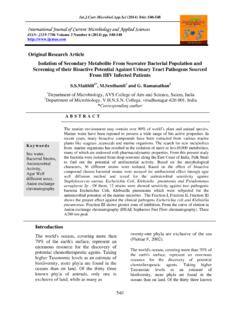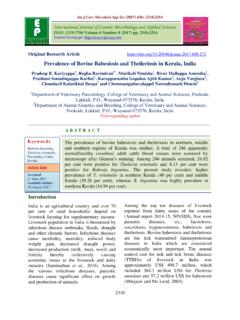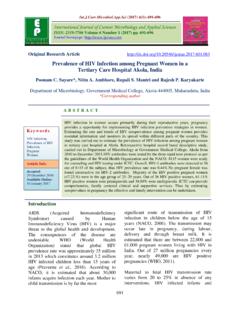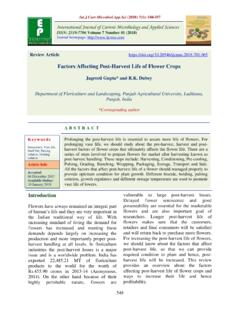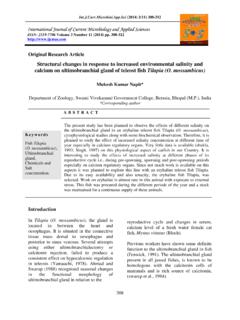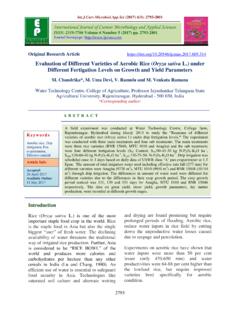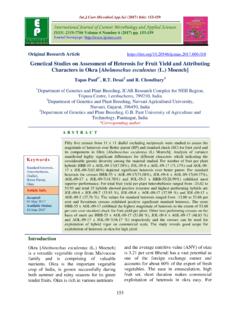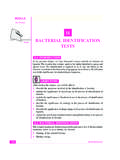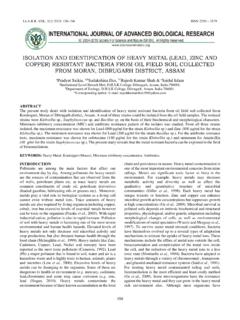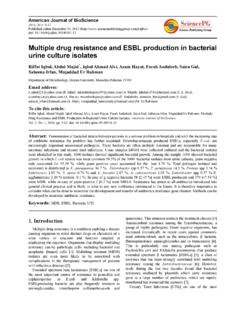Transcription of Isolation and Characterization of Microorganisms …
1 (2017) 6(6): 2707-2713 2707 Original Research Article Isolation and Characterization of Microorganisms from Agriculture Soil of Magnifera indica Orchard Y. C. Rashmi1*, R. Reshmi1, R. Poornima2 and Sujeet Kumar2 1 Mount Carmel College, Palace Road Bangalore, India 2 Department of Plant Biotechnology, University of Agricultural Sciences, GKVK, Bengaluru-560065, India *Corresponding author A B S T R A C T Introduction Mango (Mangifera indica L.) is an important fruit crop of the tropical and subtropical countries (Litz, 2009). The mango tree is considered to have evolved in the rainforests of South and South-east Asia (Knight, 1980; Krishna and Singh, 2007). India is the largest producer of mango in the world, contributing to nearly 46% of the total world production.
2 The major constrain of mango production is many devastating diseases (Lim and Khoo, 1985; Iqbal et al., 2006; Rajput and Rao, 2007). A range of Microorganisms are involved in these diseases such as fungi, algae and bacteria (Litz, 2009). These microbes cause sets of symptoms including dieback, spots, necrosis, mildew scab, blotch, anthracnose and rots in mango trees (Ploetz, 2003; Freeman et al., 1999; Haggag and Abd El-Wahab, 2009). Pseudomonas syringae and Xanthomonas sp. (causing apical necrosis and bacterial black spot respectively) are among the few known bacterial pathogens of mango International Journal of Current Microbiology and Applied Sciences ISSN: 2319-7706 Volume 6 Number 6 (2017) pp. 2707-2713 Journal homepage: A broad range of Microorganisms are present in soil of mango orchard which involved in various mango plant diseases.
3 In order to preliminary study for plant pathogenesis the soil samples were collected from GKVK, University of Agricultural Science, Bangalore, Karnataka, India. A number of bacterial and fungal isolates were obtained from soil sample. The bacterial isolates were characterized by Gram staining, Catalase test, MR test, VP test, IND test and Citrate test and fungal isolates were characterized by staining. These analyses revealed the presence of various bacterial pathogen including Klebsiella pneumoniae, Enterobacter aerogenes, Shigella species, Bacillus anthracis, Bacillus subtilis, Staphylococcus species, Streptococcus species, Corynebacterium, Micrococcus, Azomonas species and Rhizobium species. Identification of Aspergillus niger, Aspergillus flavus, Fusarium oxysporum, Penicillium and Rhizopus species characterized as a fungal pathogen.
4 The present study provided baseline information regarding the phytopathogenic bacteria and fungus which associated with soil of mango orchard. K e y w o r d s Mango, Bacterial pathogen, Fungal pathogen, Biochemical test. Accepted: 26 May 2017 Available Online: 10 June 2017 Article Info (2017) 6(6): 2707-2713 2708 trees (Cazorla et al., 1998; Pruvost et al., 2005; Ah-You et al., 2007). Currently, mango trees in India are suffering from a disease with symptoms like Dieback, Powdery Mildew, Anthracnose/Blossom Blight, Mango Malformation, Alternaria Leaf Spot, Bacterial Canker, Stem End Rot, Gummosis and Root Rot (Kumar et al., 1993; Ploetz, 2001; Khanzada et al., 2004; Youssef et al., 2007). There exists a lot of diversity of regarding the prevalence of microorganism in mango orchard soil of various parts of the world.
5 In India, however, scant information is available about the prevalence of microorganism strains in various parts of the country. Understanding local pathogen genetic diversity is the first step in a successful integrated disease management programme. One of the purposes of the present investigation on Isolation of microorganism form mango orchard soils of Karnataka is to characterize biochemically. Materials and Methods Soil Sample collection Soil samples were collected from the six sites as unmoist soil, moist soil, shaded soil, unshaded soil, Aged soil and new sapling soil of mango orchard of University of Agricultural Sciences, Bangalore, Karnataka, India. These different sites helpful for capture the diversity of the Microorganisms . The soil samples (0-15cm depth) were collected from each site into freshly unused polythene bags.
6 Pure culture For reducing microbial population, 1 g of soil was dissolved in 10 ml of sterile distilled water to make soil suspension. Serial dilution was carried out for getting isolated single colony. In this research, nutrient agar medium was used for bacterial growth and PDA for fungal growth. 28 g of nutrient agar was dissolved in 1000 ml distilled water and 39 g of PDA is dissolved in 1000 ml of distilled water and sterilized in autoclave for 15 min at 1210C. Streaking plate method was used to get single colonies of pure culture. Sample inoculums One ml of 10-5 dilution of soil suspension was plated out as innocula onto freshly prepared sterile nutrient agar medium in petridishes (Bacterial growth). The innocula were evenly spread on the surface of the nutrient agar plates by using a sterile bent glass rod.
7 After incubation for 24-48 hrs at 370C, mucous colonies were formed over the plates. Similarly for fungal growth 1ml of 10-7 dilution of soil suspension were plated out as innocula onto freshly prepared sterile Potato Dextrose Agar (PDA) medium in Petri dishes. The innocula were evenly spread on the surface of the PDA plates by using a sterile bent glass rod. After incubation for 48-72 hrs at 280C, fungus colonies were formed over the plates. Gram staining A loop full of the bacterium was spread on a glass slide and fixed by heating on a very low flame. Aqueous crystal violet (Himedia) solution ( ) was spread over the smear for 30 seconds and then gently washed with slow running tap water for one minute. It was then flooded with iodine for one minute, rinsed in tap water and decolorized with 95% ethanol until colorless runoff.
8 After washing, the specimen was counter-stained with safranin (Himedia) for approximately 10 seconds, washed with water, dried and observed under microscope at 40X using immersion oil (Schaad, 1980). Biochemical tests Biochemical tests such as Indole test, Catalase test, MR test, VP test, IND test and citrate test (2017) 6(6): 2707-2713 2709 were carried out to find the enzymatic activity of isolated organism. Indole test One percent (1%) of tryptone broth was inoculated with a bacteria colony. Incubate inoculated tubes at 370C for 48 hours. After 48 hours of incubation, add 1ml of Kovac s reagent and then shake the tubes gently and allow standing for 20 minutes. The formation of the red coloration at the top layer indicated positive and yellow coloration indicates negative.
9 Catalase test This was carried out by putting a drop of Hydrogen peroxide on all 6 clean slides. With the edge of another slide, a colony of organism was picked and allowed to be in contact with the hydrogen peroxide. Presence of bubbles indicates positive reaction and absence of bubbles indicates negative reaction. MR-VP test Prepare a MR-VP broth of pH and then pour the 5ml of broth in each of 6 test tubes and sterilize by autoclaving at 15 lb pressure for 15 min. Inoculate the test tubes with test organism and incubate all the tubes at 370C for 48-72 hrs, after which add 5 drops of methyl red indicator to all the tubes, a red color formation signifies a positive methyl red test and yellow color signifies a negative methyl red test.
10 To the rest of the broth tubes add 5 drops of 4% potassium hydroxide (KHO) were added followed by some 15 drops of 5% alpha naphtol in ethanol. Shake the tubes gently for 1min and allow the reaction to complete for about 30-45 min. The red color formation indicates a VP positive test while no color change indicates VP negative test. Citrate utilization test Prepare the Simmon s citrate agar pH This was carried out by inoculating the test organism in all test tubes containing simmon citrate medium and after inoculation, these test tubes were incubated at 370C for 48-72 hrs. The development of deep blue color after incubation indicates a positive result. IND test Inoculate the tryptophan broth with broth culture or emulsify isolated colony of the test organism in tryptophan broth.
